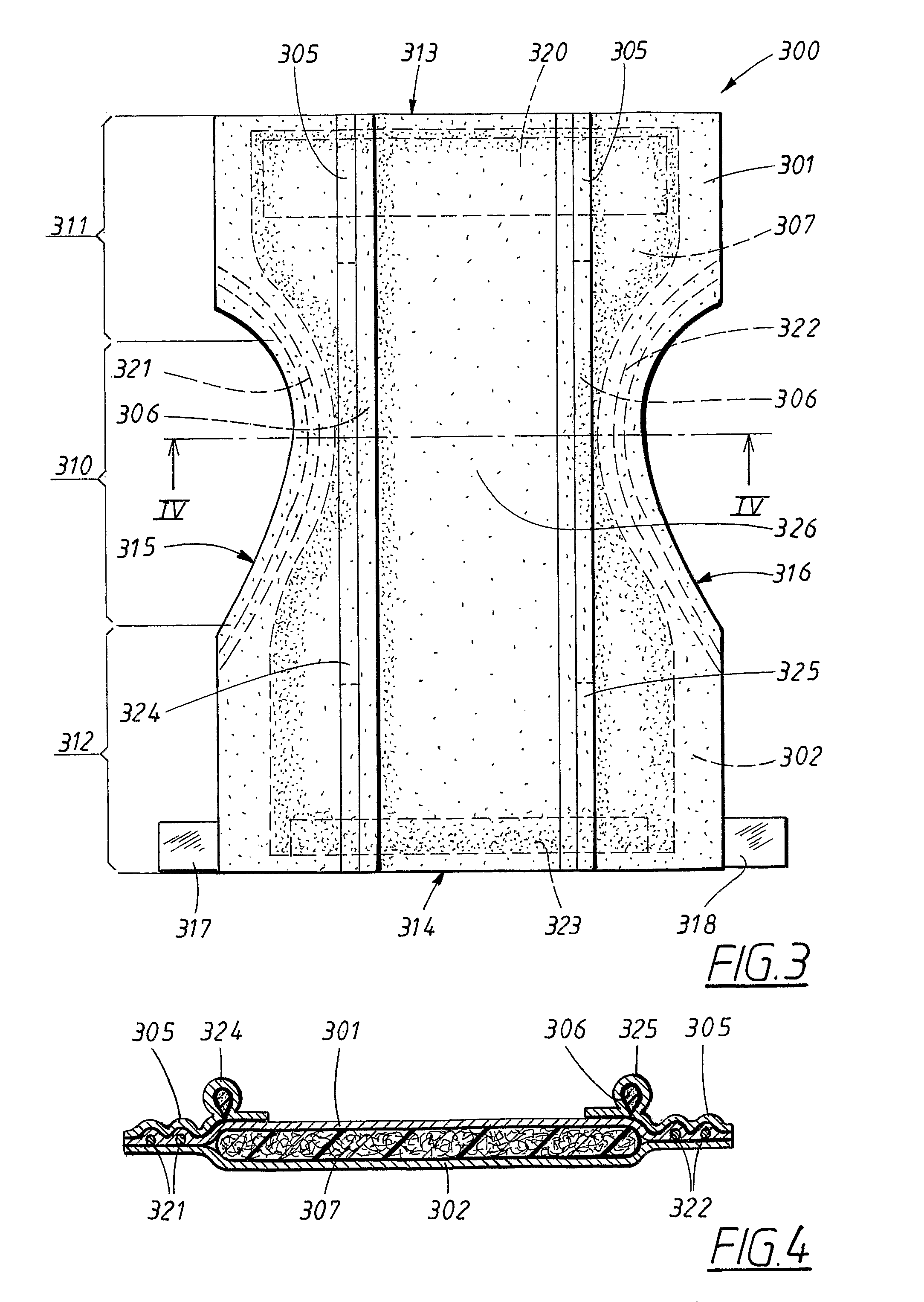Absorbent article comprising a liquid-permeable material layer
a liquid-permeable material and absorbent article technology, applied in the field of absorbent articles, can solve the problems of difficult handling of three-dimensional parts in the manufacturing process, large difficulty in manufacturing and storage of three-dimensional absorbent articles, and very soft viscose foam after use, etc., to achieve a smaller packaging space, good resistance to undesired compression or other deformation, and easy packaging
- Summary
- Abstract
- Description
- Claims
- Application Information
AI Technical Summary
Benefits of technology
Problems solved by technology
Method used
Image
Examples
example 1
Measurement of Expansion of Foam Material
[0071]When the expansion in the thickness direction of the material was measured, samples were punched out with a known diameter. The dry diameter (dt) and the dry thickness (tt) were measured. The samples were then allowed to swell for 1 minute in NaCl solution (0.9 weight percent NaCl). The wet diameter (dv) and the wet thickness (tv) were then measured.
[0072]The percentage thickness expansion (TE), the percentage area expansion (AE) and the percentage volume expansion (VE) were then calculated according to the formulae below.
TE=(tv−tt) / tt×100
AE=(dv2−dt2) / dt2×100
VE=(tvdv2−ttdt2) / ttdt2×100
The material which was tested is a polyacrylate-based foam which is denoted Foam XII. Foam XII has been manufactured according to the description below.
[0073]The following was added to a beaker:[0074]348.5 grams acrylic acid (4.84 mol)[0075]135.5 grams of a 37.3 weight percent natrium acrylate solution (0.54 mol)[0076]28.0 grams polyethylene glycol diacryla...
example 2
[0083]The total absorption capacity per unit of volume of the absorbent structure in dry condition was determined for five different samples.
[0084]Sample A is a mixed structure of chemically-produced cellulose pulp from Weyerhauser and polyacrylate-based superabsorbent in particle form from BASF. The mixed structure contains 40 weight percent superabsorbent material, based on the total weight of the sample.
[0085]Sample B is a fibre structure from Weyerhauser. The fibre structure contains 80 weight percent cross-linked cellulose and 20 weight percent thermofibres.
[0086]Sample C is a polyester fibre layer with polyacrylate-based superabsorbent in particle form bound to the polyester fibre layer. Based on the total weight of the sample, the proportion of polyacrylate-based superabsorbent is 60 percent.
[0087]Sample D is a polyacrylate-based superabsorbent foam layer. The foam layer is denoted Foam XII and is described in detail in Example 1.
[0088]Sample E is a viscose...
example 3
Stiffness of Sample Bodies with Limited Expansion Space
[0093]In order to investigate the change in the stiffness and thus the shape stability of the absorbent material which has been allowed to absorb liquid under conditions where the expansion ability of the absorbent material has been limited in accordance with the invention, the following test was carried out:
[0094]Sample bodies were produced from the various absorbent materials. The sample bodies were rectangular with a width of 0.01 m and a thickness of 0.0044 m. The length of the samples is not critical as long as it exceeds 0.04 m. The sample bodies were enclosed in a liquid-permeable tube-shaped nonwoven sleeve, as is shown in FIG. 7. The diameter of the sleeve 702 was chosen so that the sample 701 was left a certain pre-determined and limited expansion space defined by the length Lw of the excess material which is shown in FIG. 7 between one of the ends of the sample and a weld 703 arranged to fasten the sleeve into a tube ...
PUM
 Login to View More
Login to View More Abstract
Description
Claims
Application Information
 Login to View More
Login to View More - R&D
- Intellectual Property
- Life Sciences
- Materials
- Tech Scout
- Unparalleled Data Quality
- Higher Quality Content
- 60% Fewer Hallucinations
Browse by: Latest US Patents, China's latest patents, Technical Efficacy Thesaurus, Application Domain, Technology Topic, Popular Technical Reports.
© 2025 PatSnap. All rights reserved.Legal|Privacy policy|Modern Slavery Act Transparency Statement|Sitemap|About US| Contact US: help@patsnap.com



